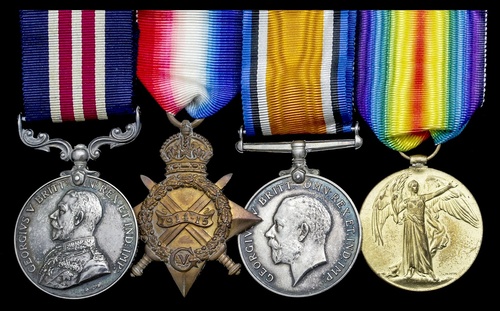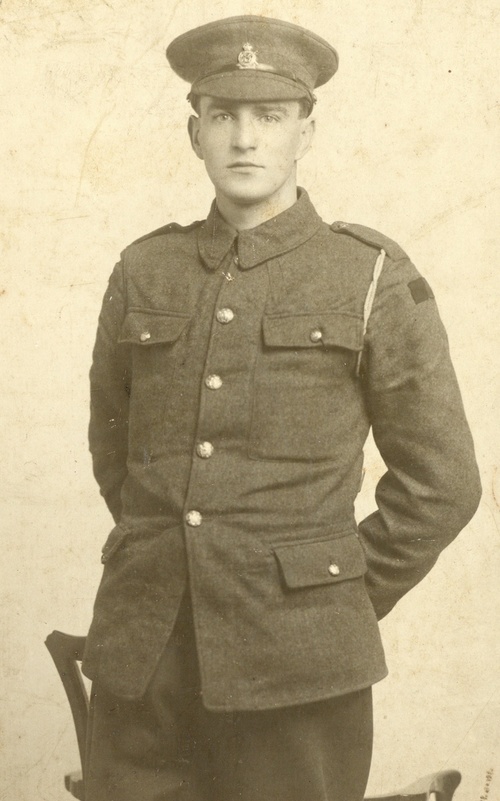Auction: 17002 - Orders, Decorations and Medals
Lot: 256
(x) A rare Great War sharpshooter's Egypt and Palestine operations M.M. group of four awarded to Lance-Corporal H. J. 'Acco' Atkinson, 1/3rd County of London Yeomanry (Sharpshooters): a gallant veteran of considerable campaigning under the most challenging of circumstances - incessant flies, sandstorms and thirst among them - he somehow managed to survive the additional challenges posed by belligerent ranks of Bedouins, Bulgars and Turks
Military Medal, G.V.R. (265349 L. Cpl. H. Atkinson, 1/3 Co. of Lond. Yeo. - T.F.); 1914-15 Star (1357 Pte. H. J. Atkinson, 3-Co. of Lond. Y.); British War and Victory Medals (1357 Pte. H. J. Atkinson, 3-Co. of Lond. Y.), together with a set of related miniature dress medals, a 3rd County of London Yeomanry badge, in gilt and enamel, and his British Legion lapel badge, generally very fine or better (6)
M.M. London Gazette 10 April 1918.
Hugh James Atkinson was born in Tottenham, London on 6 May 1891 and enlisted in the 1/3rd County of London Yeomanry (Sharpshooters) shortly after the outbreak of hostilities.
Embarked with his regiment for Egypt in April 1915, he landed at Suvla Bay, Gallipoli on 18 August 1915, and was quickly in action in an unsuccessful attack against Scimitar Hill: although the regiment was only in the third line of assault, it still suffered many casualties.
Two months of trench duty ensued in the forward areas bordering Chocolate Hill and owing to mounting casualties the regiment was amalgamated into the 4th London Regiment, 2nd Composite Brigade: Atkinson and his fellow survivors must have been much relieved to be ordered to Mudros in early November.
The Sharpshooters were afterwards deployed to the east side of the Suez Canal, where apart from the occasional exchange of fire with over-zealous Bedouin, the unit enjoyed a relatively peaceful stay until November 1916. In the latter month, however, it was ordered to Greek Macedonia to prop up the B.E.F. fighting the Bulgarians: it proved a frustrating tour of duty and culminated in a failed attack on enemy positions above Lake Doiran in April 1917.
On their arrival back in Egypt, the Sharpshooters discovered they were to reinforce the Desert Mounted Corps under Allenby: after a march of 157 miles across the Sinai Desert in 20 days, they joined the line between Gaza and Beersheba. Following the capture of the latter place in October 1917, the Yeomanry and ANZAC cavalry set off in hot pursuit, the Sharpshooters being among those chosen to attack the Turks dug-in on El-Maghar ridge, between Gaza and Jaffa. This they did with notable success and by mid-November they were leading the advance through Judea to the approaches of Jerusalem: it was a difficult advance, slowed by sandstorms and lack of water.
Yet, as concluded by Boris Mollo, in his history of the Sharpshooters, the campaign proved to be one of the last successful major campaigns undertaken by British cavalry:
'For a month the Yeomanry, Australian and New Zealand cavalry regiments had sustained their advance in terrible conditions and in that time defeated a Turkish army of many divisions, strongly entrenched, and had advanced over 50 miles, an incredible distance for those times. They had to spend as much time fighting dismounted as mounted and the high standards achieved by Sharpshooters in the Boer War were once again put to good advantage.'
Atkinson was awarded the M.M.
In April 1918, his regiment was amalgamated with the City of London Yeomanry (Roughriders) to form a machine-gun battalion, which unit was embarked for France that June. Titled the 103rd Battalion, M.G.C., the unit took over a section of the Anzin area in August 1918 and lent valuable service in the final months of the war.
Sold with a quantity of original documentation and photographs, including:
(i)
The recipient's Great War period photograph album, entitled in ink, 'Snaps of Egypt & Palestine', and containing a multitude of images and postcards (approximately 110), many of them of 'Sharpshooter' interest, and consequently of regimental significance; together with a large quantity of family photographs, several of the Edwardian era and mounted on card.
(ii)
A quantity of family birth, marriage and death certificates, and the recipient's British Passport, as issued in April 1948.
(iii)
A Sharpshooter's reunion volume, 25 October 1955, privately bound, green leather, morocco interior boards, gilt titles, and containing four pages filled with veterans' signatures, in addition to a frontispiece pencil sketch of a Sharpshooter, signed by Harry Riley; together with an inserted card inscribed to 'Acco'.
(iv)
A copy of Boris Mollo's The Sharpshooters (Historical Research Unit, London, n.d., circa 1970).
Subject to 5% tax on Hammer Price in addition to 20% VAT on Buyer’s Premium. For more information please view Terms and Conditions for Buyers.
Sold for
£1,000







